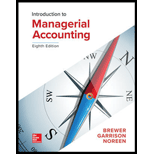
What is the meaning of contribution margin ratio? How is the ratio useful in planning business operations?
Contribution Margin: It is a margin which shows the share of sales revenue which is not covered by variable cost of a company.
Contribution Margin ratio: Contribution margin ratio is the ratio of contribution margin to net sales revenue in terms of percentage.
: Contribution margin ratio and its uses in planning business operations
Answer to Problem 1Q
Solution: A contribution margin is the amount available for coverage of fixed expenses of the business operations. When the contribution margin is expressed in percentage of sales, it is called a contribution margin ratio. It is helpful in fixing a price for a product and analyzing the impacts of revenue at different level of unit sales.
Explanation of Solution
: In simple words, a contribution margin is the difference between the sales revenue and variable cost of the product. A contribution margin ratio represents the percentage of sales revenue for meeting the fixed expenses of business operations. A company can predict or estimate its operating income based upon the contribution margin ratio. A negative or low contribution margin indicates low opportunity for making profit and high risk of loss.
For Example, if the selling price per unit of a product is $10 and variable expenses per unit is $6, the contribution margin ratio will be:
: A contribution margin is computed by deducting the variable expenses from the sales revenue of the company. The contribution margin ratio is ascertained by dividing the contribution margin with sales revenue of the company. As the contribution margin is used for meeting the fixed expenses, hence, the higher the contribution margin ratio, there is a better chances that the company might make handsome income from operations.
Want to see more full solutions like this?
Chapter 6 Solutions
Loose Leaf For Introduction To Managerial Accounting
- Financial Accountingarrow_forwardMason (single) is a 50 percent shareholder in Angels Corporation (an S Corporation). Mason receives a $184,500 salary working full time for Angels Corporation. Angels Corporation reported $418,000 of taxable business income for the year. Before considering his business income allocation from Angels and the self-employment tax deduction (if any), Mason's adjusted gross income is $184,500 (all salary from Angels Corporation). Mason claims $59,000 in itemized deductions. Answer the following questions for Mason. c. b. Assuming the business income allocated to Mason is income from a specified service trade or business, except that Angels Corporation reported $168,000 of taxable business income for the year. What is Mason's deduction for qualified business income? Ignore the wage-based limitation when computing the deduction.arrow_forwardPlease give me true answer this financial accounting questionarrow_forward
- Principles of Accounting Volume 2AccountingISBN:9781947172609Author:OpenStaxPublisher:OpenStax College
 Principles of Cost AccountingAccountingISBN:9781305087408Author:Edward J. Vanderbeck, Maria R. MitchellPublisher:Cengage Learning
Principles of Cost AccountingAccountingISBN:9781305087408Author:Edward J. Vanderbeck, Maria R. MitchellPublisher:Cengage Learning Cornerstones of Cost Management (Cornerstones Ser...AccountingISBN:9781305970663Author:Don R. Hansen, Maryanne M. MowenPublisher:Cengage Learning
Cornerstones of Cost Management (Cornerstones Ser...AccountingISBN:9781305970663Author:Don R. Hansen, Maryanne M. MowenPublisher:Cengage Learning  College Accounting, Chapters 1-27 (New in Account...AccountingISBN:9781305666160Author:James A. Heintz, Robert W. ParryPublisher:Cengage Learning
College Accounting, Chapters 1-27 (New in Account...AccountingISBN:9781305666160Author:James A. Heintz, Robert W. ParryPublisher:Cengage Learning Managerial AccountingAccountingISBN:9781337912020Author:Carl Warren, Ph.d. Cma William B. TaylerPublisher:South-Western College Pub
Managerial AccountingAccountingISBN:9781337912020Author:Carl Warren, Ph.d. Cma William B. TaylerPublisher:South-Western College Pub Financial And Managerial AccountingAccountingISBN:9781337902663Author:WARREN, Carl S.Publisher:Cengage Learning,
Financial And Managerial AccountingAccountingISBN:9781337902663Author:WARREN, Carl S.Publisher:Cengage Learning,





